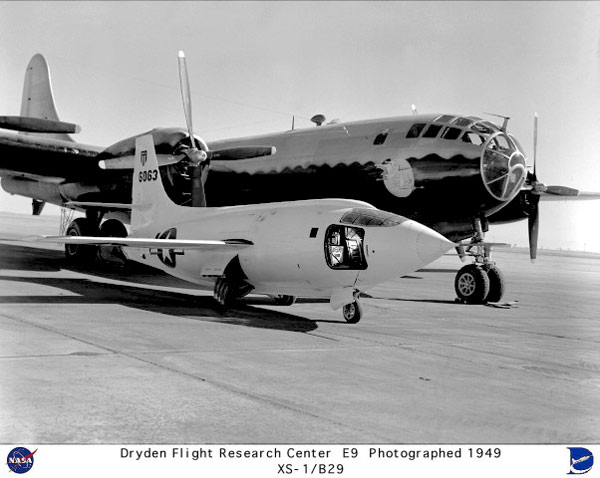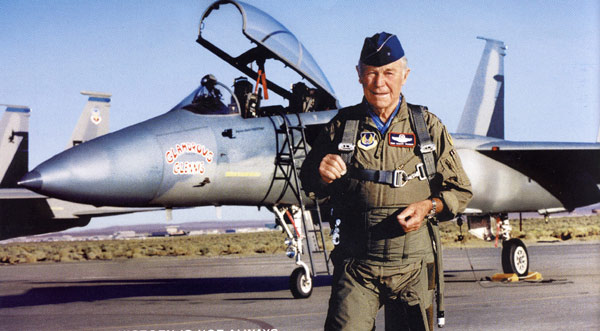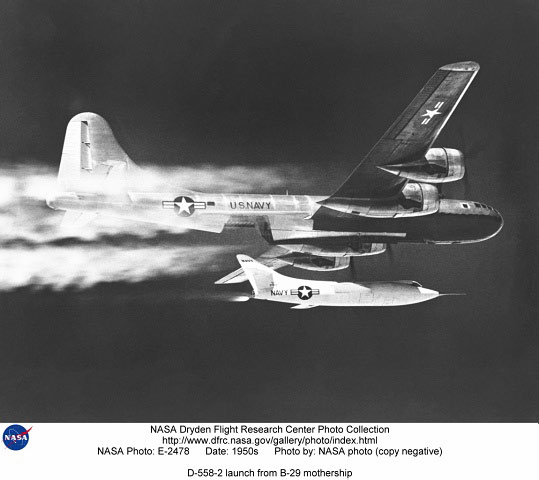XS-1 WITH B-29 MOTHERSHIP - NASA ARCHIVES - Page 2

Photo ctsy: NASA Archives
XS-1 WITH B-29 MOTHERSHIP
Photo Description:
XS-1 on the ramp with the B-29 mothership in 1949. This is the second XS-1 built; it later was converted
into the X-1E. Unlike the XS-1-1, which was flown by the Air Force, the XS-1-2 was flown mostly by Bell
and NACA pilots. It gathered much more research data than the more famous XS-1-1, known as "Glamorous
Glennis."
Project Description:
The first of the rocket-powered research aircraft, the X-1 (originally designated the XS-1), was a bullet-shaped
airplane that was built by the Bell Aircraft Company for the US Air Force and the NACA. The mission of the
X-1 was to investigate the transonic speed range (speeds from just below to just above the speed of sound)
and, if possible, to break the "sound barrier."
The first of the three X-1s was glide-tested at Pinecastle Army Air Field, FL, in early 1946. The first
powered flight of the X-1 was made on Dec. 9, 1946, at Edwards Air Force Base with Chalmers Goodlin, a Bell
test pilot, at the controls.

USAF Captain Chuck Yeager, Pilot. Photo ctsy: NASA Archives
On Oct. 14, 1947, with USAF Captain Charles "Chuck" Yeager as pilot, the aircraft flew faster than the speed of sound for the first time. Captain Yeager ignited the four-chambered XLR-11 rocket engines after being air-launched from under the bomb bay of a B-29 at 21,000 feet. The 6,000-pound thrust ethyl alcohol/liquid oxygen burning rockets, built by Reaction Motors, Inc., pushed the aircraft up to a speed of 700 miles per hour in level flight.
Captain Yeager was also the pilot when the X-1 reached its maximum speed, 957 miles per hour. Another USAF pilot. Lt. Col. Frank Everest, Jr., was credited with taking the X-1 to its maximum altitude of 71,902 feet. Eighteen pilots in all flew the X-1s. The number three plane was destroyed in a fire before ever making any powered flights.
A single-place monoplane, the X-1 was 30 feet, 11 inches long; 10 feet, 10 inches high; and had a wingspan
of 29 feet. It weighed 6,784 pounds and carried 6,250 pounds of fuel. It had a flush cockpit with a side
entrance and no ejection seat.
NASA Photo by: NASA

D-558-2 LAUNCHED FROM NAVY P2B-1S
Photo Description:
The D-558-2 is launched from the Navy P2B-1S in this 1950s photograph. The early Douglas and NACA flights
of the D-558-2s used only the airplane's jet engine and took off from the runway. This limited the aircraft's
altitude and speed. The solution was to convert the D-558-2 to rocket or combined jet-and-rocket propulsion
and to airdrop it from a B-29 converted to the Navy's P2B-1S configuration.
|
MOVIE: D-558-2 UNDER B-29 The drop plane was P2B-1S serial number 84029. It had been built as a B-29A (Army Air Forces 45-21787) before being modified as a drop plane for the Navy. Dubbed "Fertile Myrtle," the mothership used the call sign "NACA 137." |
Project Description:
The Douglas D-558-2 "Skyrockets" were among the early transonic research airplanes like the X-1,
X-4, X-5, and X-92A. Three of the single-seat, swept-wing aircraft flew from 1948 to 1956 in a joint program
involving the National Advisory Committee for Aeronautics (NACA), with its flight research done at the NACAs
Muroc Flight Test Unit in Calif., redesignated in 1949 the High-Speed Flight Research Station (HSFRS); the
Navy-Marine Corps; and the Douglas Aircraft Co. The HSFRS became the High-Speed Flight Station in 1954 and
is now known as the NASA Dryden Flight Research Center. The Skyrocket made aviation history when it became
the first airplane to fly twice the speed of sound.
Douglas pilot John F. Martin made the first flight at Muroc Army Airfield (later renamed Edwards Air Force Base) in Calif. on February 4, 1948. The goals of the program were to investigate the characteristics of swept-wing aircraft at transonic and supersonic speeds with particular attention to pitch-up (uncommanded rotation of the nose of the airplane upwards)--a problem prevalent in high-speed service aircraft of that era, particularly at low speeds during take-off and landing and in tight turns.
The three airplanes flew a total of 313 times--123 by the number one aircraft (Bureau No. 37973--NACA 143), 103 by the second Skyrocket (Bureau No. 37974--NACA 144), and 87 by airplane number three (Bureau No. 37975--NACA 145). Skyrocket 143 flew all but one of its missions as part of the Douglas contractor program to test the airplanes performance.
NACA aircraft 143 was initially powered by a Westinghouse J-34-40 turbojet engine configured only for ground take-offs, but in 1954-55 the contractor modified it to an all-rocket air-launch capability featuring an LR8-RM-6, 4-chamber Reaction Motors engine rated at 6,000 pounds of thrust at sea level (the Navy designation for the Air Forces LR-11 used in the X-1). In this configuration, NACA research pilot John McKay flew the airplane only once for familiarization on September 17, 1956. The 123 flights of NACA 143 served to validate wind-tunnel predictions of the airplanes performance, except for the fact that the airplane experienced less drag above Mach 0.85 than the wind tunnels had indicated.
| << previous page | next page >> |